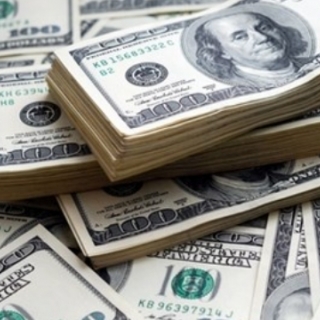


The dollar held ground in choppy trading on Monday, as investors monitored the fighting between Israel and Iran for signs that it could escalate into a broader regional conflict and braced for a week packed with central bank meetings.
As both Iran and Israel showed no signs of backing off from their attacks, market participants mulled the prospect that Tehran might seek to choke off the Strait of Hormuz - the world's most important gateway for oil shipping. This could raise broader economic risks from disruptions in the energy-rich Middle East.
The dollar, which until recently had always been the ultimate safe haven in times of geopolitical or financial turmoil, held at 144.14 Japanese yen after rising nearly 0.4% earlier on Monday. The euro was marginally up at $1.157.
The U.S. unit was also steady against the Swiss franc at 0.811, while an index that measures the dollar against six other currencies dipped 0.3% and was last at 98.02.
Oil prices fell 1%, following Friday's 7% rally to near six-month highs in the wake of Israel's preemptive strike on Iran.
"Obviously oil markets are a bit nervous" given risks around supply disruption, said Kenneth Broux, head of corporate research FX and rates at Societe Generale.
Currencies that are positively correlated to risk such as the Australian dollar and the New Zealand dollar were half a percentage point higher, while the oil-exposed Norwegian crown was flat after hitting its highest since early 2023 earlier in the day.
On Friday, investors had bought back into the dollar, which has lost more than 9% in value against a basket of six other currencies this year as U.S. President Donald Trump's move to reshape the global trade order heightened economic uncertainty.
But analysts were less convinced that the trend could continue until there was more clarity on the tariff front.
"Investors have come in and have bought the dip (of other currencies against the dollar)," Broux said.
"So for me, the takeaway is that we are still in an environment where investors are more inclined to sell USD. And that's the setup into the FOMC."
The U.S. Federal Reserve gives its latest policy decision on Wednesday, with the Israel-Iran conflict adding complexity for policymakers who have been trying to navigate this year's events.
Investors remain nervous over Trump's deadline on trade deals due in about three weeks, while agreements with major trade partners including the European Union and Japan are yet to be signed.
They will look for progress in any bilateral meetings with the U.S. on the sidelines of a Group of Seven leaders' meeting in Canada.
"The G7 no longer represents major event risk for FX but trade talks are likely to feature prominently in the discussions among leaders and progress here would add to the positive risk mood," analysts at Scotiabank said.
Meanwhile, sterling, the euro and the Australian dollar gained 0.2% to 0.4% over the Japanese currency.
Source: Reuters
The dollar fell due to disappointing US jobs data, with layoffs reaching more than 150,000 in October, the highest in over 20 years. Another factor: the market is now considering the possibility that...
The US Dollar trims losses on Friday with investors wary of risk following another sell-off on Wall Street, as concerns of an AI bubble remain alive. The USD Index, which measures the value of the Dol...
The U.S. dollar edged up on Wednesday, extending its gains from last week on doubts about the outlook for another Fed rate cut this year and as private payrolls data assuaged worries over the state of...
The US dollar held near a three-month high on Tuesday (November 4th) as a divided Federal Reserve prompted traders to reduce their bets on a rate cut, while the Japanese yen strengthened after a verba...
The US dollar held near a three-month high on Monday (November 3rd) ahead of economic data this week that will provide only vague clues about the health of the US economy and could reinforce the Feder...
Hong Kong stocks rose on Monday morning (November 10, 2025) after data showed Chinese consumer prices rose 0.2% year-on-year in October—the highest increase since January. This news fueled hopes that deflationary pressures in the world's...
Gold prices rose to $4,050 per ounce on Monday (November 10), driven by increased demand for safe-haven assets amid political uncertainty in the US. Investors are still awaiting a final agreement to end the government shutdown, which has lasted...
Global stock markets rallied at the start of the week amid growing optimism that the US government shutdown will soon end. S&P 500 futures rose 0.5%, while the Nasdaq 100 gained 0.8%, after Senate Republican leader John Thune said a deal to end...
 European stocks fell on Friday as investors digested more quarterly earnings, but weekly losses were inevitable, with concerns regarding overheated...
European stocks fell on Friday as investors digested more quarterly earnings, but weekly losses were inevitable, with concerns regarding overheated...
 Two weeks before the US Federal Reserve's final meeting, with the federal government's data taps closed, Atlanta Fed staff bolstered their economic...
Two weeks before the US Federal Reserve's final meeting, with the federal government's data taps closed, Atlanta Fed staff bolstered their economic...
 US stocks rebounded from early losses to close mostly higher on Friday amid hopes that Congress members were making progress toward ending the...
US stocks rebounded from early losses to close mostly higher on Friday amid hopes that Congress members were making progress toward ending the...
 European markets opened higher on Friday (November 7th), recovering some of the previous session's losses amid concerns about an AI bubble. The...
European markets opened higher on Friday (November 7th), recovering some of the previous session's losses amid concerns about an AI bubble. The...